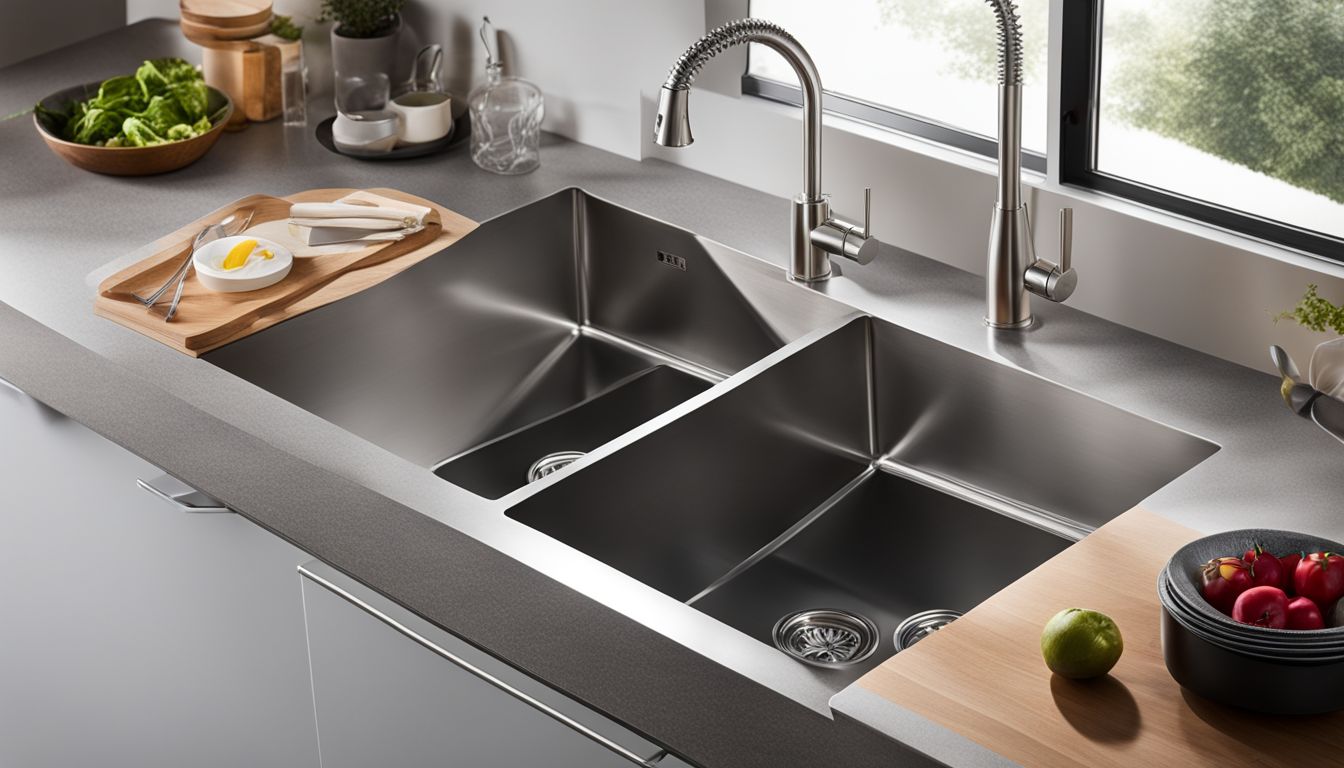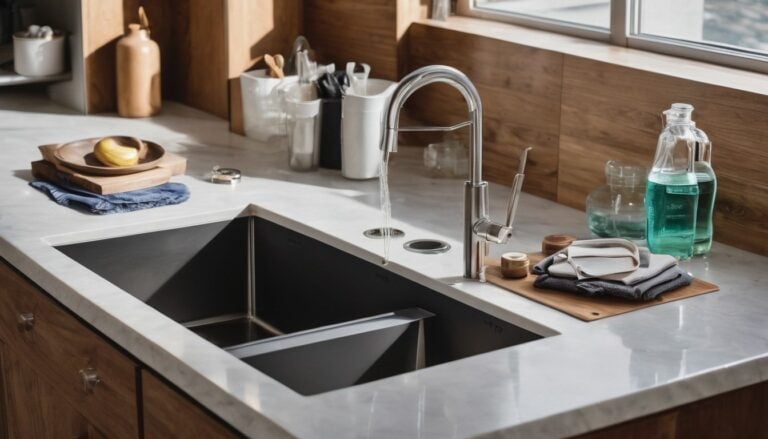Revamp Easily: Can I Get a New Kitchen Sink Without Replacing Countertop?
Does the thought of giving your kitchen a minor facelift by swapping out the sink sound appealing? But does that appeal fade as you consider having to replace the entire countertop too and face potential added costs? Trust me, you’re not alone in this.
We’ve all battled with our worn-out sinks while staring at an otherwise perfectly fine countertop, feeling defeated. However, I bring good news: it’s entirely feasible to replace your kitchen sink without disturbing the countertop! This comprehensive blog post is here to navigate you through every step of this process while carefully considering factors like size, cost-effectiveness and possible bumps along the way.
Buckle up; your journey toward a revitalized kitchen is just around the bend!
Key Takeaways
- It is possible to replace a kitchen sink without replacing the entire countertop by considering factors such as size, mounting type, and compatibility.
- Preserving the existing countertop saves money and time, while also preserving memories associated with it.
- Proper measurement of the sink and countertop is crucial before selecting a new sink that fits the existing cutout.
- Different types of sink mounting options include drop – in sinks, undermount sinks, dual mount sinks, and farmhouse sinks.
- Removing a kitchen sink without damaging the countertop can be done by following proper steps and using appropriate tools and techniques.
- Factors to consider before deciding to replace the countertop include cost, condition of the current countertop, age, style, and functionality.
- The average cost of replacing a kitchen sink is significantly less than replacing a countertop. Sink replacement costs around $429 on average while countertop replacement costs around $4,000 on average.
Can You Replace a Kitchen Sink Without Replacing the Countertop?

Before diving into the process of replacing a kitchen sink, it’s essential to determine whether or not you can do so without having to replace the entire countertop.
Factors to consider before replacing a sink
I want to share with you some key factors before you start replacing your kitchen sink.
- Sink Size: Compare sizes of the old and new sinks. If the new one is smaller, gaps may form, and the sink may not be steady.
- Countertop Condition: Look at your countertop. If it’s in good shape, you might not need a new one. But if it’s damaged, a replacement would be best.
- Sink Type: Some sinks need more work to install than others. An undermount sink takes more time and care to put in place than drop-in ones.
- Installation Needs: Each sink type needs special steps for installation. Make sure you know what these are before buying a new sink.
- Help from Pros: Some jobs can be tough to do alone. You might need help from a pro when replacing an undermount sink without taking out the countertop.
Importance of preserving the existing countertop
Keeping the existing countertop is important. It saves money and time. You don’t have to buy a new one or hire someone to put it in. Your kitchen stays nice during the sink change.
But there’s more! A saved countertop keeps memories alive. Maybe you remember cooking with your kids on this countertop or making holiday meals for family and friends. So, when you keep your old countertop while getting a new sink, you keep all those good times too.
Size Matters

When replacing a kitchen sink without replacing the countertop, it’s essential to consider the size of both the sink and the existing cutout in the countertop.
Measuring the sink and the countertop
I need to tell you about measuring your kitchen sink and countertop. It’s the first step before getting a new sink.
- Get your tape measure ready. Start from one side of your sink, stretch it across to the other end. Note down this length.
- For the width, put the tape measure’s edge on one side of your sink and pull it across to the other side.
- Don’t forget to check how deep your sink is too! Measure from the top edge down to the bottom.
- Usually, kitchen sinks are 24” or 36” wide, but always measure yours just to be safe.
- To measure your countertop, start from one end and pull your tape measure across horizontally to get its length.
- Follow these same steps for getting its width as well.
Finding a sink that fits the existing cutout
To find a sink that fits the existing cutout in your kitchen, you need to consider its size and shape. Measure the dimensions of the current sink accurately from underneath before removing it.
This will help ensure that you choose a new sink with matching dimensions. However, keep in mind that sometimes the existing cutout may not fit a new sink perfectly. In such cases, you may need to customize or enlarge the cutout to accommodate a larger or differently shaped sink.
It’s important to hire a professional for this task as they have the expertise and tools needed to avoid damaging your countertop. When selecting a new sink, consider different installation types, materials, and sizes to find one that fits well with your kitchen layout and worktop.
How Is It Mounted?
When replacing a kitchen sink without replacing the countertop, it’s important to consider how the sink is mounted and if it is compatible with the existing countertop.
Different types of sink mounting
There are different types of sink mounting options for kitchen sinks. These include:
- Drop-in sink: This is the most common type of sink installation. The sink is placed into a hole cut into the countertop and rests on the edges of the hole.
- Undermount sink: This type of sink requires a more precise installation. It is mounted underneath the countertop and needs to be securely fastened.
- Dual mount sink: This type of sink can be installed as either a drop-in or undermount sink, depending on your preference and style.
- Farmhouse sink: These sinks have a large, exposed front panel that extends beyond the edge of the countertop. They are a popular choice for rustic or traditional kitchen designs.
Compatibility with existing countertop
Choosing a new kitchen sink that is compatible with your existing countertop is important to ensure a smooth installation process. Factors such as the type of sink, dimensions, and drain location should be considered when selecting a replacement sink.
For example, if you have granite countertops, you will need to choose a sink that is compatible with this material. Additionally, the faucet installation should also be taken into account when considering compatibility.
By carefully considering these factors, you can find a new sink that fits well with your existing countertop without any issues or damage.
Can It Be Removed Without Damaging the Countertop?
Removing a kitchen sink without damaging the countertop is possible by following proper steps and using appropriate tools and techniques.
Steps to safely remove a sink from the countertop
Removing a sink from the countertop can be done safely with these steps:
- Check underneath the countertop for any fasteners holding the sink in place.
- Use a pry bar to carefully loosen and remove the sink, being cautious not to damage the sink or countertop.
- Place a towel between the pry bar and the sink or countertop to prevent any potential damage.
- If the sink is caulked to the countertop, use a razor blade to break through the caulking and release the sink.
- In some cases, the countertop may need to be cut to fit a new sink. This can be done using tools like a power saw, jigsaw, and drill.
- Apply waterproof sealant for a proper fit between the new sink and countertop.
Using proper tools and techniques
To remove a kitchen sink without damaging the countertop, it’s important to use the right tools and techniques. One of the essential tools you’ll need is either a sawzall or a circular saw to cut through the plywood or countertop surrounding the sink.
This will allow you to separate the sink from the countertop without causing any damage. Additionally, it’s helpful to leave a couple of inches of countertop connected to the sink before removing it.
This way, you can easily detach the sink from the countertop. By using these proper tools and techniques, you can successfully remove your kitchen sink without replacing the entire countertop.
Is Your Kitchen Countertop Worth Saving?
Before deciding to replace your kitchen countertop, it’s important to consider factors such as its condition, durability, and overall cost in comparison to replacing the sink.
Factors to consider before deciding to replace the countertop
Before deciding to replace your kitchen countertop, it’s important to consider a few factors:
- Cost: Replacing a countertop can be expensive, with costs ranging from $400 to $4,340 depending on the material and size.
- Condition: Assess the condition of your current countertop. If it’s in good shape and only the sink needs replacing, it may be more cost-effective to keep the existing countertop.
- Age: Consider the age of your countertop. If it’s relatively new and still in good condition, it may not make sense to replace it just for a sink upgrade.
- Style: Think about how well your current countertop matches your kitchen’s overall style and design. If you’re happy with its look, there may be no need to replace it.
- Functionality: Evaluate if your current countertop meets your needs in terms of durability, maintenance, and functionality. If it does, replacing only the sink may be sufficient.
Cost comparison between sink replacement and countertop replacement
The cost comparison between replacing a sink and a countertop is a critical factor to consider when contemplating a kitchen update. The average cost of replacing a kitchen sink is considerably less than replacing a countertop.
| Component | Average Replacement Cost |
|---|---|
| Kitchen Sink | $429 |
| Kitchen Countertop | $4,000 |
As noted from the table above, the average cost to replace a kitchen sink is around $429. This figure can range from $216 to $642 depending on the specific sink model and related installation costs. On the other hand, replacing a kitchen countertop could set you back around $4,000 on average. This cost could even stretch up to $8,000 depending on the material and the size of the countertop. It’s quite clear there’s a vast difference in cost, with countertop replacement being significantly more expensive than sink replacement. However, certain factors, like choosing a luxury sink, might necessitate some countertop work, incurring additional costs.
Is It Time to Replace Your Sink or Kitchen Countertop?
Are you noticing signs of wear and tear on your sink or countertop? It may be time to consider a replacement.
Signs that your sink or countertop needs to be replaced
Here are some signs that indicate it may be time to replace your sink or kitchen countertop:
- Water damage: If you notice water leaking under the sink or pooling around the countertop, it could be a sign of a leaky sink or damaged countertop.
- Sink damage: Cracks, chips, or warping in the sink itself can affect its functionality and appearance.
- Leaking sink: Constant leaks from the faucet or plumbing connections can lead to water damage and indicate the need for a new sink.
- Cracked countertop: Over time, countertops can develop cracks and chips due to regular use, which not only affects their aesthetics but also their durability.
- Chipped countertop: Similar to cracks, chips in the countertop can be unsightly and may eventually worsen if left unaddressed.
- Erosion on countertop: Excessive wear and tear on the countertop surface may result in erosion over time, compromising its functionality.
- Scorch marks on countertop: If you frequently place hot pots and pans directly on your countertop without protection, scorch marks can appear and make your kitchen look worn-out.
- Stains on countertop: Stubborn stains that cannot be removed even with proper cleaning techniques may indicate permanent damage to the surface of your countertop.
- Insufficient kitchen space: If you find yourself constantly running out of workspace in your kitchen, it may be time to consider replacing your sink or expanding your countertop area.
- Faucet replacement: If you need to replace an old faucet but it requires modifying or damaging the existing sink or countertops, it might be more practical to replace them altogether.
Factors that can affect the lifespan of a sink or countertop
Water damage is a significant factor that can affect the lifespan of a sink or countertop. If there are any water leaks or moisture around the sink rim, it can lead to damage and shorten their lifespan.
Water stains on the countertop may indicate potential water damage, which should be addressed promptly. Additionally, the materials used for both the sink and countertop play a crucial role in their durability and resistance to stains, scratches, and heat.
Choosing high-quality materials will help ensure their longevity. The size of the kitchen sink also matters as it should fit well within the countertop space while meeting your needs.
Removing a Kitchen Sink Without Damaging the Countertop
To remove a kitchen sink without damaging the countertop, follow these step-by-step instructions and use proper tools and techniques to ensure minimal impact on the existing surface.
Step-by-step guide for removing different types of kitchen sinks
Removing a kitchen sink can be done without damaging the countertop. Here’s how:
- Gather the necessary tools: screwdriver, pliers, and a putty knife.
- Turn off the water supply to the sink and disconnect any plumbing connections.
- If you have a top – mounted sink with metal clips, locate them underneath the countertop edge.
- Use a screwdriver to unscrew the metal clips and remove them from the countertop.
- Gently lift the sink up and out of the cutout in the countertop.
- If you have an undermounted sink, locate any adhesive or sealant used to secure it to the underside of the countertop.
- Use a putty knife or similar tool to carefully scrape away the adhesive or sealant.
- Once all adhesive is removed, gently lift and detach the sink from underneath the countertop.
- Clean any leftover residue or debris from both the sink and countertop surfaces.
Tips for preventing damage to the countertop
To prevent damage to your countertop when replacing a kitchen sink, there are a few important tips to keep in mind. First, consider hiring a professional who can safely cut the counter to fit the new sink without causing any harm.
If the countertop cannot be removed without damage, it may be best to replace the counters altogether. Additionally, water stains around the sink rim can lead to damage underneath, so it’s crucial to address these issues promptly.
To minimize potential damage during removal, cutting plywood strips can make it easier and safer to take out both the countertop and sink. Remember that taking precautions and consulting with experts will help you determine the best approach for replacing your kitchen sink while preserving your countertop.
Alternative Solutions for Kitchen Sink Replacement
One alternative solution for kitchen sink replacement is installing a new sink on top of the existing countertop. This can be done by choosing a drop-in or undermount sink that fits into the cutout of your current countertop without needing any major modifications.
Installing a new sink on top of the existing countertop
When installing a new sink on top of the existing countertop, there are a few things to consider. Here are some important points:
- Measure the dimensions: Make sure the new sink will fit properly on the existing countertop. Measure the length, width, and depth of both the sink and the cutout in the countertop.
- Check for compatibility: Ensure that the new sink is compatible with the existing countertop material. Some sinks may work better with certain types of countertops, such as stainless steel sinks with laminate countertops.
- Remove the old sink: Before installing the new sink, you’ll need to remove the old one first. Follow proper procedures and use appropriate tools to safely detach the old sink from the countertop without causing damage.
- Prep the surface: Clean and prepare the countertop surface for installation by removing any debris or residue left from removing the old sink. Smooth out any uneven areas or bumps on the countertop.
- Install the new sink: Carefully lower your new sink into place on top of the existing countertop cutout. Ensure that it sits snugly and securely in place.
- Caulk around the edges: Apply a bead of silicone caulk around all edges of your new sink to create a watertight seal between it and your countertop.
- Test for leaks: Once everything is installed, turn on your water supply and check for any leaks around your new sink and along its connections.
Using a sink conversion kit
If you’re looking for an alternative solution to replacing your kitchen sink without having to replace the countertop, using a sink conversion kit is a great option. A sink conversion kit allows you to install a new sink on top of your existing countertop.
It eliminates the need for traditional installation methods that involve removing and replacing the entire countertop. This not only saves you time but also money, as it avoids the cost of purchasing and installing a brand new countertop.
So if you’re looking for a cost-effective way to update your kitchen sink without replacing the countertop, consider using a sink conversion kit.
Conclusion
In conclusion, it is possible to get a new kitchen sink without replacing the countertop. However, whether or not you need to replace the countertop depends on factors such as size and mounting type.
Taking proper precautions when removing the old sink can help prevent damage to the countertop. Consider these factors before making any decisions about your kitchen sink upgrade.
FAQs
1. Can I replace my kitchen sink without replacing the countertop?
Yes, it is possible to replace your kitchen sink without replacing the countertop as long as the new sink fits properly and matches the existing plumbing connections.
2. How do I know if a new sink will fit in my existing countertop?
To determine if a new sink will fit in your existing countertop, measure the dimensions of both the current sink opening and the new sink you are considering. Ensure that there is enough space and that any necessary modifications can be made.
3. Do I need to hire a professional to install a new kitchen sink?
While it is possible to install a new kitchen sink yourself if you have basic plumbing knowledge, hiring a professional plumber is recommended for proper installation and to ensure everything functions correctly.
4. Will replacing just my kitchen sink improve its appearance?
Replacing just your kitchen sink can enhance its appearance, especially if you choose a modern or stylish design that complements your overall kitchen decor. However, keep in mind that other factors such as countertops, backsplash, and cabinets also contribute to the overall look.
5. What steps should I take when replacing my kitchen sink without changing the countertop?
When replacing your kitchen sink without changing the countertop, first select a suitable replacement that matches measurements and style preferences. Then, disconnect plumbing connections carefully before removing old fixtures and installing the new one with proper sealing techniques. Finally, reconnect all plumbing connections securely before testing for leaks.







